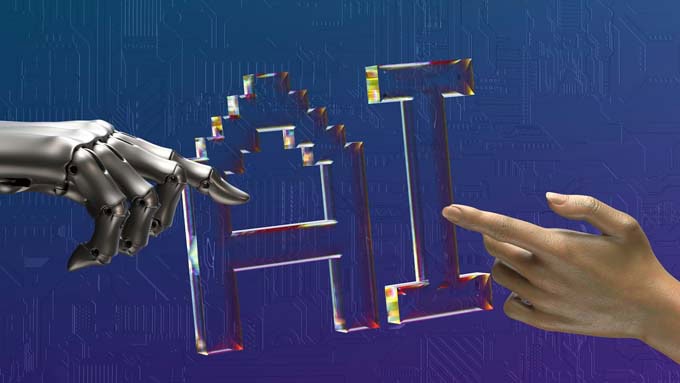Real-world AI much bigger than GenAI
Real-world AI will shape the future much more than the generative AI models that are popular today, such as ChatGPT, Google Gemini or Grok from X.ai, predicts the Diplomatic Council think tank, which is part of the United Nations' closest circle of advisors. AI in the real world ranges from autonomous manufacturing to smart cities.

Examples of applications for "AI in the real world", often referred to as "physical AI", include manufacturing robots and humanoids, quality control with AI cameras, predictive machine and plant maintenance, autonomous logistics systems, medical diagnostics, self-driving cars and smart cities. The Diplomatic Council's Real-World AI Forum invites you to an online conference on the use of AI in cities and communities on September 22.
Smart City use case
"The true value of AI lies not in the hype surrounding the generation of texts, images and videos, but in its profound integration into the core processes of industry and local authorities," explains Harald Müller, Managing Director of the Bonn Business Academy (BWA) and Co-Chair of the Real-World AI Forum at the Diplomatic Council. Dr. Daniel Trauth, also Co-Chair of the forum and Managing Director of Cologne-based dataMatters GmbH, uses the example of the Smart City to illustrate the benefits. According to him, municipalities could save around 20 percent in costs and reduce CO2 emissions by around 30 percent through AI optimization of waste management alone. AI-controlled traffic lights and networked traffic management systems with real-time parking space information lead to a reduction in traffic jams and further reduce CO2 emissions. A recent McKinsey study shows that smart city solutions can reduce energy consumption in public buildings by up to 15 percent (Smart Building).
Another example is the optimization of public transport. Dr. Daniel Trauth explains the procedure clearly: "LiDAR and optical sensors in buses and trains can be used to record exactly how many seats and standing places are occupied at which times on which lines, or how many children or adults use the service. This data is analyzed using artificial intelligence and the AI can use it to make real-time recommendations for the optimal use of precisely these buses and trains. As a result, this leads to greater public transport acceptance among citizens, more targeted staff deployment and reductions in costs and environmental impact."
Application area "intelligent machining"
Dr. Daniel Trauth cites "intelligent machining" as an example of an industrial AI application with far-reaching effects, on which his company dataMatters is working together with the Fraunhofer Institute for Production Technology IPT in Aachen, among others. Essentially, the aim is to use AI to meet the high quality requirements in the machining industry better and more cost-effectively. Machining, in which material is brought into the desired shape and size by turning, drilling, milling or grinding, forms an essential basis of manufacturing technology in many branches of industry, from automotive production to the manufacture of medical instruments.
Errors in the machining process can have serious consequences, ranging from product failures to safety problems. Strict quality controls are therefore essential, but also time-consuming and expensive. "Automated monitoring and analysis of production processes using AI can significantly reduce inspection times and costs for quality assurance and improve the accuracy of quality assessment," says Dr. Daniel Trauth, explaining the benefits of "Real World AI" using this application example.
"Machining is just one of countless areas of application for artificial intelligence in manufacturing," says Harald Müller. Ultimately, it is about autonomous factories, i.e. production halls devoid of people, in which only robots are active. These "ghost factories" are made possible by a combination of computer technology, networking, artificial intelligence, robotics and innovative manufacturing processes. According to studies, this could reduce operating costs by up to 25 percent, increase productivity by up to 30 percent and reduce error rates by up to 40 percent.
Smart Factory for more competitiveness
Despite the higher initial investment for the construction of a smart factory, where around a third of the total costs are accounted for by sensors, software and infrastructure, the construction of an autonomous factory often pays for itself within the first year of operation. This is primarily due to the significantly reduced wage bill. "In addition, the increased flexibility leads to a faster response to market changes and the higher quality level reduces rework costs, which ultimately increases customer satisfaction," says Harald Müller, outlining the competitive advantages of the new production generation.
The BWA boss clarifies: "This is not a glimpse into the distant future, but is already beginning to become reality in the form of autonomous production twins." An APT - a digital twin in production - combines real-time data, artificial intelligence and advanced networking to create a virtual representation of the production system that can make decisions and adapt processes independently. "An autonomous production twin can actively control production processes and react to unforeseen events, for example by adjusting the robot speed, optimizing the material supply, correcting errors or rescheduling in the event of material bottlenecks," says Harald Müller, giving specific examples of the benefits of using AI in production.
He summarizes: "While generative AI is a useful tool, real-world AI delivers the sustainable efficiency and cost benefits that will shape the economy and communities of the future. Companies that recognize this change early on and embed AI in their physical infrastructure will secure a decisive competitive advantage. In view of the current crisis situation in Germany, the domestic industry must not miss out on this development under any circumstances."
Source and further information: www.diplomatic-council.org/de/ki-in-der-realen-welt
This article originally appeared on m-q.ch - https://www.m-q.ch/de/real-world-ai-viel-groesser-als-genai/









